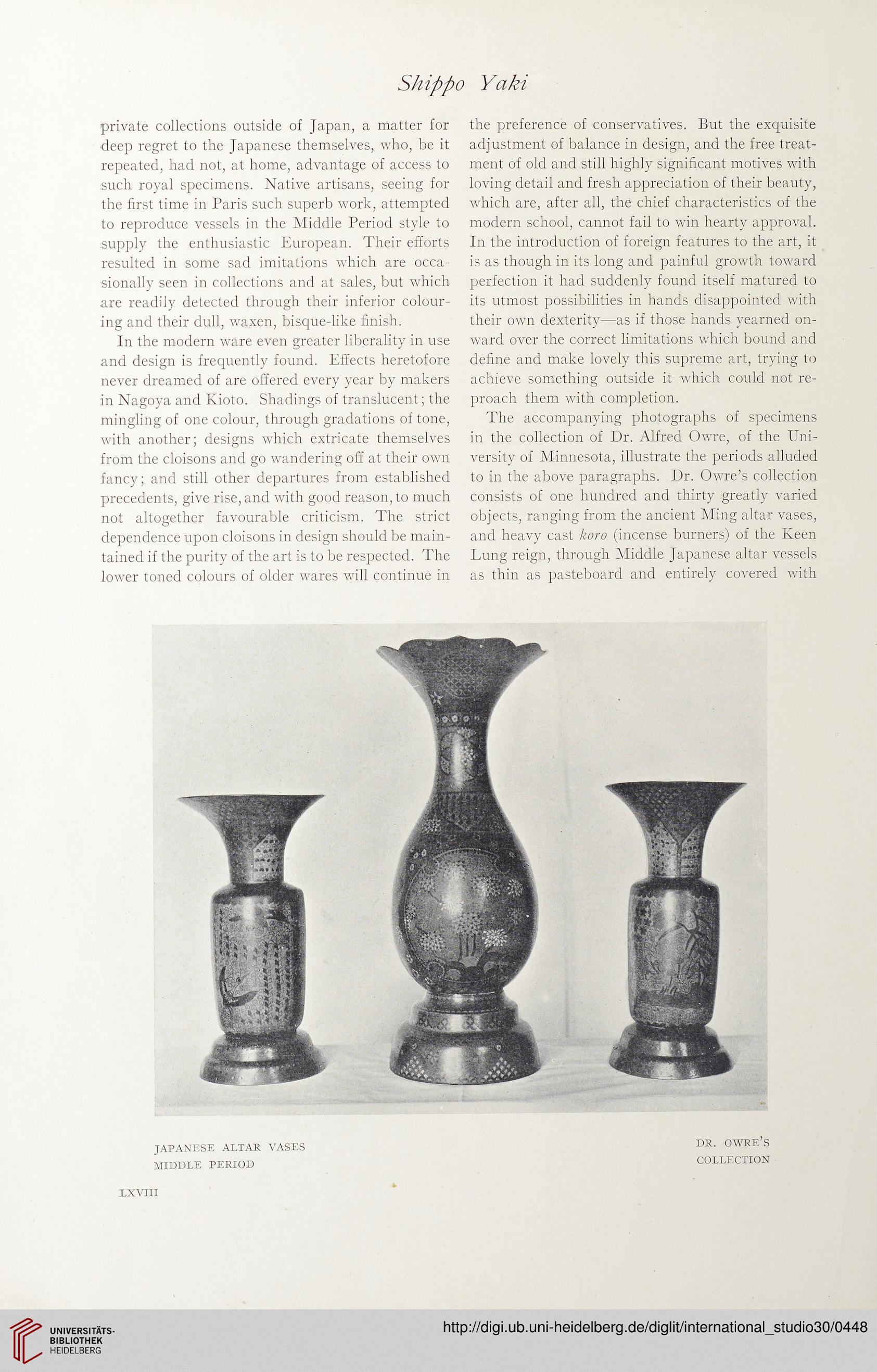Shippo Yaki
private collections outside of Japan, a matter for
deep regret to the Japanese themselves, who, be it
repeated, had not, at home, advantage of access to
such royal specimens. Native artisans, seeing for
the first time in Paris such superb work, attempted
to reproduce vessels in the Middle Period style to
supply the enthusiastic European. Their efforts
resulted in some sad imitations which are occa-
sionally seen in collections and at sales, but which
are readily detected through their inferior colour-
ing and their dull, waxen, bisque-like finish.
In the modern ware even greater liberality in use
and design is frequently found. Effects heretofore
never dreamed of are offered every year by makers
in Nagoya and Kioto. Shadings of translucent; the
mingling of one colour, through gradations of tone,
with another; designs which extricate themselves
from the cloisons and go wandering off at their own
fancy; and still other departures from established
precedents, give rise, and with good reason, to much
not altogether favourable criticism. The strict
dependence upon cloisons in design should be main-
tained if the purity of the art is to be respected. The
lower toned colours of older wares will continue in
the preference of conservatives. But the exquisite
adjustment of balance in design, and the free treat-
ment of old and still highly significant motives with
loving detail and fresh appreciation of their beauty,
which are, after all, the chief characteristics of the
modern school, cannot fail to win hearty approval.
In the introduction of foreign features to the art, it
is as though in its long and painful growth toward
perfection it had suddenly found itself matured to
its utmost possibilities in hands disappointed with
their own dexterity—as if those hands yearned on-
ward over the correct limitations which bound and
define and make lovely this supreme art, trying to
achieve something outside it which could not re-
proach them with completion.
The accompanying photographs of specimens
in the collection of Dr. Alfred Owre, of the Uni-
versity of Minnesota, illustrate the periods alluded
to in the above paragraphs. Dr. Owre’s collection
consists of one hundred and thirty greatly varied
objects, ranging from the ancient Ming altar vases,
and heavy cast koro (incense burners) of the Keen
Lung reign, through Middle Japanese altar vessels
as thin as pasteboard and entirely covered with
JAPANESE ALTAR VASES DR. OWRE’S
MIDDLE PERIOD COLLECTION
XXVIII
private collections outside of Japan, a matter for
deep regret to the Japanese themselves, who, be it
repeated, had not, at home, advantage of access to
such royal specimens. Native artisans, seeing for
the first time in Paris such superb work, attempted
to reproduce vessels in the Middle Period style to
supply the enthusiastic European. Their efforts
resulted in some sad imitations which are occa-
sionally seen in collections and at sales, but which
are readily detected through their inferior colour-
ing and their dull, waxen, bisque-like finish.
In the modern ware even greater liberality in use
and design is frequently found. Effects heretofore
never dreamed of are offered every year by makers
in Nagoya and Kioto. Shadings of translucent; the
mingling of one colour, through gradations of tone,
with another; designs which extricate themselves
from the cloisons and go wandering off at their own
fancy; and still other departures from established
precedents, give rise, and with good reason, to much
not altogether favourable criticism. The strict
dependence upon cloisons in design should be main-
tained if the purity of the art is to be respected. The
lower toned colours of older wares will continue in
the preference of conservatives. But the exquisite
adjustment of balance in design, and the free treat-
ment of old and still highly significant motives with
loving detail and fresh appreciation of their beauty,
which are, after all, the chief characteristics of the
modern school, cannot fail to win hearty approval.
In the introduction of foreign features to the art, it
is as though in its long and painful growth toward
perfection it had suddenly found itself matured to
its utmost possibilities in hands disappointed with
their own dexterity—as if those hands yearned on-
ward over the correct limitations which bound and
define and make lovely this supreme art, trying to
achieve something outside it which could not re-
proach them with completion.
The accompanying photographs of specimens
in the collection of Dr. Alfred Owre, of the Uni-
versity of Minnesota, illustrate the periods alluded
to in the above paragraphs. Dr. Owre’s collection
consists of one hundred and thirty greatly varied
objects, ranging from the ancient Ming altar vases,
and heavy cast koro (incense burners) of the Keen
Lung reign, through Middle Japanese altar vessels
as thin as pasteboard and entirely covered with
JAPANESE ALTAR VASES DR. OWRE’S
MIDDLE PERIOD COLLECTION
XXVIII





